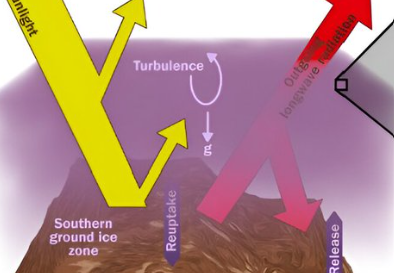Theories and ideas keep flowing when it comes to mankind extending civilization to Mars. One thing never thought of by the public is we have MILLIONS of square miles here on Earth full of resources and far more habitable than Mars. Antarctica and Siberia as examples. Would it not be about 1000 times easier to somehow create a way to settle such areas right here on Earth? But on to Mars…
A small team of engineers and geophysicists from Northwestern University, the University of Chicago, and the University of Central Florida have developed an innovative method to heat Mars more efficiently than generating greenhouse gases. Their study, published in the journal Science Advances, suggests creating millions of metal nanorods from Martian surface material and blasting them into the atmosphere.
For years, science fiction writers have envisioned a future where Mars is made habitable through terraforming, allowing humans to survive without special buildings and spacesuits. Recently, scientists have started exploring this possibility, though with less ambitious goals. Instead of completely transforming the planet, many are considering ways to warm it up slightly to make it more habitable. Most ideas have centered on releasing greenhouse gases into the atmosphere to capture more heat from the sun. However, Mars lacks the necessary ingredients on its surface to create and release such gases effectively.
“Artificial aerosols made from materials that are readily available at Mars could warm Mars,” the researchers said.
Source: Newsweek https://t.co/yuq7xip8jo
— Spring Covington CEO of SCC Investing LLC. (@SpringCovington) August 8, 2024
The research team proposes an alternative method: releasing millions of metal nanorods into the Martian atmosphere. These nanorods could trap heat similarly to Martian dust but would remain in the atmosphere longer. The researchers compare the effort to shooting glitter into the atmosphere. They suggest that nanorods could be easily produced with materials found on the Martian surface and could potentially be reused once they fall to the ground. Initial tests showed that nanorods would settle 10 times more slowly than dust.
To determine if their idea is feasible, the researchers used the MarsWRF global climate model, along with an additional 1-D model to mimic the desired conditions. After incorporating data on the addition of metal nanorods into the atmosphere, they ran the model to observe the outcomes. The model showed that if the nanorods were fired at a rate of 30 liters per second into the atmosphere, the entire planet would warm by 30 K (equivalent to 30°C or 54°F). Furthermore, if this firing were sustained for at least 10 years, ice on the Martian surface would begin to melt.
The Mars Society Convention in August will host a new breakthrough in terraforming.
The concept is suspending iron or aluminum nanorods in Mars’ atmosphere. Consequent warming will release more CO2 from ice & soil, creating a powerful greenhouse effect.https://t.co/LdjhqI0mz0
— BlueJ (@BlueJ11274903) June 23, 2024
The research team suggests that using metal nanorods to warm Mars would be far more efficient than attempting to do so with greenhouse gases. This approach represents a novel and potentially more practical method of terraforming Mars, bringing humanity one step closer to making the Red Planet a more hospitable place for future explorers.
Key Points:
i. Innovative Heating Method: Researchers propose using metal nanorods to heat Mars more efficiently than greenhouse gases.
ii. Sci-Fi to Reality: The idea stems from science fiction but focuses on making Mars slightly warmer rather than fully habitable.
iii. Nanorods Advantage: Metal nanorods could trap heat like Martian dust but stay in the atmosphere longer.
iv. Feasibility Tested: Models show that sustained nanorod release could warm Mars by 30 K and start melting surface ice within 10 years.
v. Efficient Terraforming: The method is suggested to be more efficient than greenhouse gases, potentially revolutionizing Mars terraforming efforts.
TL Holcomb – Reprinted with permission of Whatfinger News

